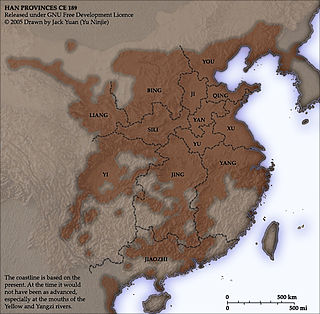Xiázhou or Xiá Prefecture (written as 硤州 before the 10th century, and 峽州 thereafter) was a zhou (prefecture) in imperial China centering on modern Yichang, Hubei, China. It existed (intermittently) from the 6th century to 1376.

Zhou were historical political divisions of China. Formally established during the Han dynasty, zhou exist continuously until the establishment of the Republic of China in 1912—a period of over 2000 years. Zhou were also previously used in Korea, Vietnam, and Japan.

The earliest known written records of the history of China date from as early as 1250 BC, from the Shang dynasty, during the king Wu Ding's reign, who was recorded as the twenty-first Shang king by the written records of Shang dynasty unearthed. Ancient historical texts such as the Records of the Grand Historian and the Bamboo Annals describe a Xia dynasty before the Shang, but no writing is known from the period, and Shang writings do not indicate the existence of the Xia. The Shang ruled in the Yellow River valley, which is commonly held to be the cradle of Chinese civilization. However, Neolithic civilizations originated at various cultural centers along both the Yellow River and Yangtze River. These Yellow River and Yangtze civilizations arose millennia before the Shang. With thousands of years of continuous history, China is one of the world's oldest civilizations, and is regarded as one of the cradles of civilization.

Yichang is a prefecture-level city located in western Hubei province, China. It is the second largest city in the province after the capital, Wuhan. The Three Gorges Dam is located within its administrative area, in Yiling District. As of the 2010 census, its population was 4,059,686 inhabitants whom 1,350,150 lived in the built-up area made of Yiling, Xiling, Wujiagang and Dianjun urban districts as Xiaoting District is not urbanized yet.







